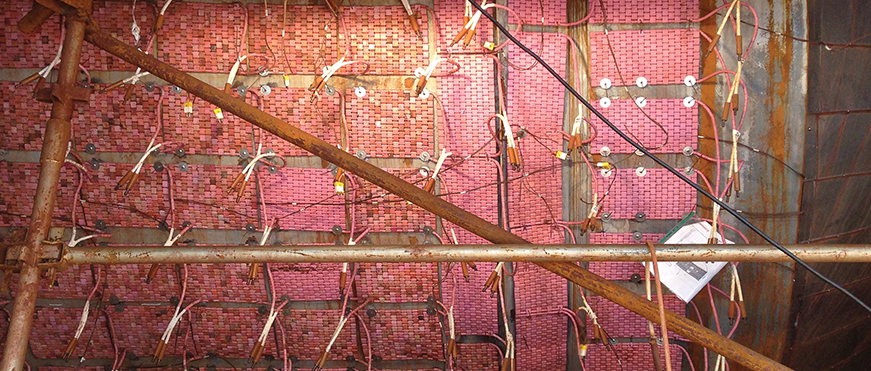Electrical Resistance

The traditional low-voltage Electrical Resistance method of heat treating uses ceramic blankets stepped down to 80 volts to provide a quick and convenient approach to many jobs, particularly preheat and PWHT. Most electrical resistance heat treating is performed either with the TEAM 6-way control console or the TEAM 18-way mobile rig.
Welding Preheat
Advanced automated systems control and document welding preheat to reduce thermal stress in three primary ways. First, it drives off moisture that would release hydrogen that could penetrate the steel and cause porosity and subsequent cracking. Second, it reduces heat loss to the surrounding metal, minimizing the rate of weld hardening and allowing hydrogen that is present to escape. And finally, it improves the microstructure and durability of the heat-affected zone.
Post-weld Heat Treatment
Carefully controlled (PWHT) is a crucial step in maximizing the life of your process equipment. PWHT tempers the metal and reduces tensile stresses, minimizing the risk of brittle fracture, stress and corrosion cracking and metal fatigue. This is especially important for equipment used in harsh service environments. Our engineers ensure the structural integrity of the vessel or unit during treatment, and our company’s advanced PLC and wireless control technology achieves the precise control needed to get the maximum benefit from the treatment.
Line Thawing and Melt-out
Team electrical resistance heating gets frozen lines flowing again quickly, and keeps them flowing until your plant’s steam tracing system is working again. For foundries that lose a heat source, our combustion services can melt out anything from zinc to steel, 800°F (427°C) to 3,000°F (1,649°C).
Hydrogen Removal
We can improve the integrity of welded components and minimize the risk of fabrication-related cracking. Used prior to cutting or welding older process equipment, our hydrogen removal technology can help protect equipment during cutting and welding as well as improve the quality of the finished work.
Heat Treatment (Annealing and Normalizing)
We offer a range of services for annealing and normalizing to alter the properties of metals that may or may not contain welds.
Decontamination
Electrical resistance heating has been successfully utilized to decontaminate huge storage tanks that once held toxic agents. The heating process drives residual chemical agents off the tank walls so they can be collected, and the tanks can be dismantled.
Wireless Heat Treating Capabilities
For large jobs, TEAM capitalizes on advanced automation to provide both control and safety. The company doesn’t promote wireless systems indiscriminately because there are important safety considerations that sometimes warrant having a technician monitor control points at the site. But for many projects, wireless technology can offer personnel savings by controlling up to 36 points using TEAM's SCADA software.
TEAM'’s wireless, computer-controlled, portable heat-treating system reduces labor costs and increases accuracy, precision and record control. This state-of the- art system allows operators to program heat cycles and variables into multiple heaters simultaneously utilizing a complex controller with multiple inputs for thermocouples and heater current. Multiple units can be linked together with either wired communications cord or a wireless transmitter to a central control point.
Wireless heat treating delivers clear, concise documentation for customers while guaranteeing chart accuracy. It also allows the chart to remain (1) on a hard drive and (2) backed up on a storage device. Documentation saved electronically and stored locally is available for fast retrieval for auditing purposes and/or duplication.
TEAM can help your company:
- Control and document welding preheat to reduce thermal stress
- Improve the microstructure and durability of the heat-affected zone
- Temper the metal and reduces tensile stresses, minimizing the risk of brittle fracture, stress and corrosion cracking and metal fatigue
- Ensure the structural integrity of the vessel or unit during treatment
- Get frozen lines flowing again quickly, and keeps them flowing until your plant’s steam tracing system
is working again - Improve the integrity of welded components and minimize the risk of fabrication-related cracking
- Decontaminate huge storage tanks that once held toxic agents